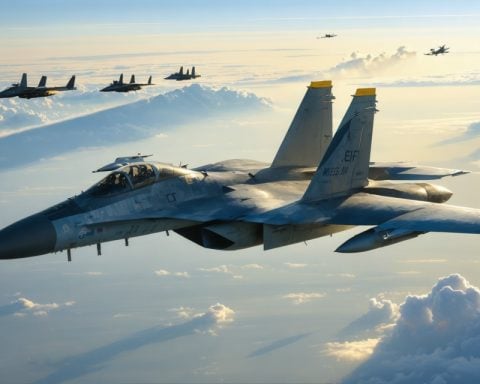- The U.S. F-15EX Eagle II and Russia’s Su-35 are top examples of fourth-generation-plus fighter jet technology.
- The Su-35 features radar-absorbent materials and advanced infrared systems for stealth and surveillance.
- The F-15EX integrates advanced processing power with an AESA radar for targeting multiple threats simultaneously.
- Both jets have a similar thrust-to-weight ratio, essential for precision in aerial dogfights.
- The F-15EX has a significant missile capacity, supporting a dozen missiles and hypersonic capabilities.
- These fighters demonstrate a blend of innovation and legacy, leading the push towards future air combat technologies.
Two giants of the skies, the U.S. F-15EX Eagle II and Russia’s Su-35, represent the pinnacle of fourth-generation-plus fighter jet technology. These aerial titans reign supreme, weaving through clouds with astounding agility while remaining paragons of technological sophistication.
The Su-35, an evolution of the venerable Su-27, prowls the skies with high-speed acuity. It combines stealth with craftsmanship, its radar-absorbent belly cloaking it from prying electronic eyes as it surveils its surroundings with advanced infrared systems. It is both a listener and a hunter, its Passive Electronically Scanned Array radar stealthily tracking adversaries over great distances.
Slicing through the azure heavens with comparable speed, the American F-15EX Eagle II showcases a fusion of power and brains. The fighter, a marriage of might and machine intelligence, harnesses the prowess of its Advanced Display Core Processor II to manage countless functions per second. With its AESA radar, the F-15EX zeros in on multiple targets, maintaining a digital ear to the sky’s whispers.
Both marvels of modern engineering share a similar thrust-to-weight ratio, a crucial balance enabling precision in dogfights. However, the Eagle flexes its muscular wings, boasting a lethal dozen missile capacity, poised to embrace the hypersonic vanguard.
In an era where stealth and speed dictate aerial dominance, both the Su-35 and the F-15EX reveal what happens when innovation meets legacy. They embody their nations’ relentless pursuit of air superiority, illustrating that the future of air combat is both in these skies and ahead of its time. As these behemoths hover on the threshold of the sixth generation, they make clear that the quest for supremacy never ceases—it only ascends to new heights.
F-15EX vs. Su-35: The Battle for Air Supremacy
Features, Specs & Pricing
F-15EX Eagle II
– Manufacturer: Boeing
– Unit Cost: Approximately $80 million
– Speed: Mach 2.5+
– Range: 1,200 nautical miles with conformal fuel tanks
– Radar: AN/APG-82 AESA radar
– Weapon Capacity: Can carry up to 22 air-to-air missiles
– Engine: Twin Pratt & Whitney F100 engines
Su-35
– Manufacturer: Sukhoi
– Unit Cost: Estimated $50-70 million
– Speed: Mach 2.25
– Range: Around 1,600 nautical miles
– Radar: Irbis-E Passive Electronically Scanned Array (PESA) radar
– Weapon Capacity: Typically equipped with 8-12 air-to-air missiles
– Engine: Twin Saturn AL-41F1S turbojet engines
Real-World Use Cases
F-15EX Eagle II
– U.S. Air Force Operations: Designed to complement stealth fighters like the F-35, the F-15EX is intended for air superiority and superior payload capacity missions.
– Potential for Foreign Sales: Nations seeking advanced capabilities without investing fully in fifth-generation stealth may opt for the F-15EX.
Su-35
– Russian Air Force: Plays a vital role in air defense and as a multipurpose fighter.
– Export Market: The Su-35 is an attractive choice for countries looking to balance performance and cost. It has been sold to nations like China and Egypt.
How-To Steps & Life Hacks
Maintenance Efficiency
– F-15EX: Future-proofing with digital architecture allows easy integration of new technologies, reducing downtime.
– Su-35: Modular design simplifies maintenance but may require more specialized technology for troubleshooting electronic warfare systems.
Market Forecasts & Industry Trends
– The demand for fourth-generation-plus fighters continues as nations look for cost-effective solutions that offer considerable advancements over older models.
– While the F-35 offers stealth capabilities, the market supports continued interest in fighters like the F-15EX and Su-35 for their versatility and lower price point.
– Both jets stand at the crossroads of transitioning aviation technology, hinting at the upcoming sixth generation with their modern upgrades and adaptability.
Reviews & Comparisons
– Performance: The F-15EX offers superior processing power and electronic capabilities, ideal for nations prioritizing data-centric warfare and payload delivery.
– Cost-Effectiveness: The Su-35 provides impressive capabilities at a relatively lower cost, making it an attractive proposition for budget-conscious air forces.
Controversies & Limitations
– Stealth Limitations: Both jets are classified as fourth-generation plus, meaning they fall short of the stealth capabilities inherent in fifth-generation fighters like the F-35 or Su-57.
– Operational Costs: High maintenance and operational costs can be a concern for both aircraft, impacting budget allocations.
Security & Sustainability
– Advancements in Electronic Warfare: Both aircraft are equipped with robust countermeasure suites to defend against electronic attacks, but ongoing upgrades are necessary to stay ahead of adversaries.
– Fuel Efficiency: Both jets are high-performance machines, consuming significant fuel; however, improvements in engine technology continue to strive for optimization.
Pros & Cons Overview
F-15EX Pros
– High payload capacity
– Advanced avionics and radar systems
– Strong upgrade potential
F-15EX Cons
– High purchase and operational cost
– Larger radar cross-section compared to stealth fighters
Su-35 Pros
– Competitive pricing
– High maneuverability with thrust-vectoring engines
– Proven combat record
Su-35 Cons
– Lesser focus on advanced sensor systems compared to Western counterparts
– Limited stealth capabilities
Conclusion & Recommendations
When choosing between the F-15EX and Su-35, consider mission requirements, budget, and operational strategy. The F-15EX offers technological superiority in avionics, while the Su-35 balances performance with cost-effectiveness. For immediate application, enhancing radar systems and investing in electronic warfare capabilities will maximize the operational potential of either aircraft.
For more insights on advanced fighter jets, visit boeing.com for the F-15EX and sukhoi.org for the Su-35.








